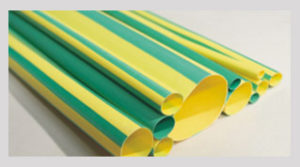
Power cable accessories are an important component in all industrial environments. Cable terminations and joints offer the necessary electrical connection, physical protection and mechanical support to the cable. Several accessories like heat shrink tubing, end-caps, cable repair sleeves, transition joints and many more have wound their way into a number of industries. Following article describes how the heat shrink tubes work in industrial settings.
A two-stage process is involved in the production of this type of tubing. The first stage includes the regular extrusion procedure and it is in the second process that the tubing obtains its heat shrink property. The tubing diameter is expanded by use of force and heat and while being in the expanded state it is cooled to room temperature. On application of heat it shrinks to its original position enclosing the application snugly. The snug fit safeguards the application from chipping, abrasion, denting, peeling or cutting. Besides this, it offers strain relief, thermal insulation and environmental seal to the cables and also helps in color-coding the specific items.
Firstly, it is necessary to select an appropriate product that is cost effective and best fulfills all the requirements with regard to sizing. The diameter of the expanded size and the post heated shrunk size that will snugly fit over the application and the minimum wall thickness to offer the required protection have to be determined for the tubing. It is essential to ascertain whether common electrical requirements like flame resistance and dielectric strength have to be met by the tubing for the application. Another component for determining your requirements is the operating environment of the tubing.
After the requirements are laid down it is essential to ascertain the correct tubing size and the heat shrink ratio assumes great importance here. Besides the shrinking of the tubing with regard to its diameter upon heat application, the longitudinal shrinkage also needs to be factored in. Next, comes deciding the appropriate material for the heat shrink. Heat shrink tubes are available in PVC, polyolefin and specialty products like elastomeric materials and fluoropolymers. Specialty products offer a number of superior advantages like resistance to extreme temperatures, extraordinary fluid/chemical compatibility or better mechanical properties. However, these products are pricey alternatives and you have to decide whether they truly serve your purpose or not.
There are various methods used for shrinking the heat shrink tubing. One of the commonly used devices in this regard is the hand-held heat gun. However, for larger quantities, a flow through oven is a better alternative. Sometimes, focused light is also used for shrinking the heat shrinks, for example, like the one emitted by halogen bulbs. Storage conditions have to be given prime importance to eliminate the possibility of premature recovery and ensure a longer shelf life. Direct sunlight has to be avoided and temperature of less than 90 degree F has to be maintained. Varied types of these products are available in the market.
The above information acts as a basic guideline for users, new to the world of heat shrink tubes and enables them to make a right choice of the product.